No pithy phrases, no comical anecdotes and no going on and on about food or chocolate. In this article I am getting right to the point. You need to know how to choose the right microphone and I want to help you make that choice wisely. In part one of this mini series (
Microphone Basic Part 1) I wrote about the two primary types of microphones: dynamic and condenser. If you haven't read that article yet go check it out and then come back to this one. Here, in part two, I am writing about how mics pick up sound. But first, let me tell you a story ...just kidding.
Every microphone picks up sound in some patterned fashion. This is called the polar pattern or directionality of the microphone. The pattern determines how much sound will be picked up at different angles in relation to the front of the microphone. This is important to know because when you pick a mic, especially for live sound. You'll want to maximize the sound you are trying to put into the mic and minimize the sound that you don't want the mic to pickup. For example, you want to capture all the sound from the vocalist that is singing but you don't want any of the sound from the monitor that they are listening to spilling into the mic.
There are five directional patterns used in microphones: omnidirectional, cardioid, supercardioid, hypercardioid and bidirectional. Most mics for live performance only have one of these patterns built into them, but there are some microphones available that have switchable patterns which means you can use one of several patterns built into that mic. Let me give you a brief description of each pattern:
Omnidirectional 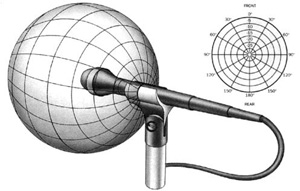
Microphones with this pattern will pick up sound evenly regardless of where the source is in relation to the front of the mic. As you can see in the nifty little picture to the right, the pickup pattern is represented as an even sphere all the way around the pick up end of the mic. There is little or no rejection of sound behind the pick up end. You might choose an omnidirectional mic for a small choral group or for some backup singers who can share a single mic. But be aware, omnidirectional mics will not only pick up your singers, they will pick up everything else as well, including stage monitors, causing unnecessary feedback. One of the most popular uses of omnidirectional mics in the church is the lapel mic. Some of the most popular models with an omni pattern are the
Audio-Technica 831CW, the
Shure WL183 and the
Sennheiser ME2.
Cardioid 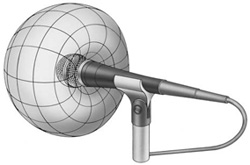
This polar pattern is by far the most popular one, especially for live sound.
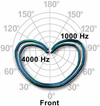
It is called cardioid because it picks up sound in a heart-shaped pattern as evidenced by the pictures to the left and right. If you compare the image to the right to the omni image above you will notice how the cardioid picks up less sound from the rear of the mic then an omni mic does. This is ideal when you have stage monitors shooting sound straight into the face of a singer but don't want that sound bleeding into your mic. A few great examples of cardioid mics are the
Audio-Technica AE4100, the
Shure SM58 and the
Sennheiser E835.
Supercardioid and Hypercardioid 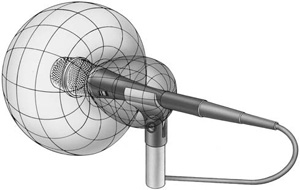
These two patterns are variations of the cardioid pattern. They still reject sound from the rear but not as well as the cardioid. The supercardioid picks up some from the rear and the hypercardioid picks up even more. Actually, a hypercardioid mic is closer in relation to a bidirectional mic than a cardioid. Several excellent handheld mics have super or hypercardioid patterns such as
Audio-Technica ATM710, the
Shure Beta 87A and the
Sennheiser E965.
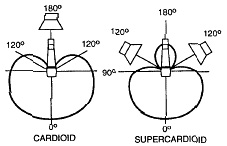
When you use a super or hypercardioid mic in a live performance make sure you arrange your stage monitors correctly. The diagram to the right should help give you a clue. Notice that while the speaker is placed directly behind the cardioid mic, it is set off to an angle for the supercardioid mic. This would be the same setup for a hypercardioid. By placing your stage monitors accordingly you should be able to get more volume out of your monitors and less feedback.
Bidirectional 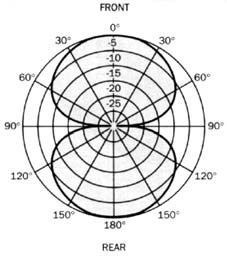
Mics with this pattern are able to pick up sound equally well to the front and to the rear of the mic element. They reject the most sound from the sides of the mic. Another name that bidirectional mics go by is Figure-8. You won't find too many bidirectional mics being used during worship services but once in a while you might find a reason to use them. I like to use them with small children's choral groups. I will place two to three kids on each side of the mic and let them have at it. I would rather place them in front of a stationary mic than give a group of kid's handheld mics. If you have ever given six children handhelds than you know what I mean (although your experience was probably blessed). A few good figure-8 mics are the
CAD GXL 3000 Studio Microphone and the
CAD TRION 7000. These are also examples of switchable pattern mics since they offer other patterns besides figure-8.
In Closing... If you run sound or are involved with the technical ministry of your church you should learn as much as you can about what you do, and that involves knowing how your microphones work. Knowing their directional patterns will help you pick the correct mic for every specific application.
 Richard Aronson
Richard Aronson is a seasoned musician and an audio / video producer. He serves as the Tech Director at Oakridge Ministries in Rainier Washington.